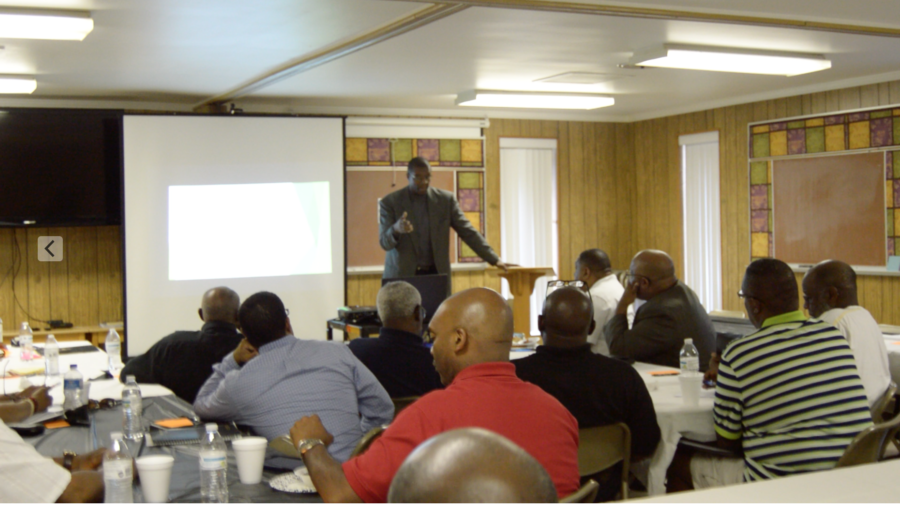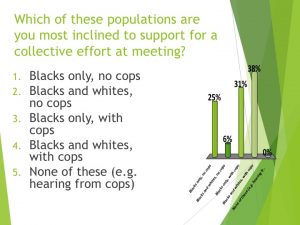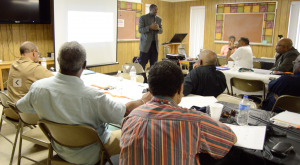
We welcome Dr. David Campt to the CELE blog. David lives near Eden, NC and works across the U.S. on many community engagement projects.
 This two-part blog entry is intended to outline some of the key decisions that confront people considering a public meeting aimed at improving relations between the police and black communities.
This two-part blog entry is intended to outline some of the key decisions that confront people considering a public meeting aimed at improving relations between the police and black communities.
- Part 1 reviews a train of logical analysis useful for sorting out different potential stakeholder groups and different formats for a potential meeting or series of meetings.
- Part 2 will focus on meeting design and facilitation lessons when doing a small group dialogue meeting on this topic.
Background and Context
Recently, I was asked by an informal group of African-American pastors in Rockingham County, North Carolina to convene what amounts of a strategic planning meeting. In light of recent national tensions between police and black communities, the pastors wanted to think through options for creating a meeting (or a series) that might improve things locally.
When considering ways a group might take action on police community relations, it is important to acknowledge that having a public meeting is merely one choice among several options. For instance, in Cate and John’s blog, anti-racism training and the Cops and Barbers program were mentioned as ways to improve relations. For the sake of this discussion, let’s assume non-meeting based approaches have already been considered. How do should people who want to consider meetings think through the broad set of options that are possible?
To address this question, I will walk through the recent meeting with the pastors. The agenda will convey some of the logic that I generally use to think through options for using convenings as to advance using public issues. This summary video (about 4 minutes) of some of the key steps in the meeting may be helpful.
After an opening prayer and introductions, I encouraged the pastors to write down their objectives for a potential meeting. These were collected and a co-facilitator began the process of sorting these objectives into themes. Next, I walked them through some ways of thinking about the advantages and complexities of two key questions
Question 1: What publics and stakeholders should be invited to the convenings?
Question 2: How should the meeting(s) be structured?
Question 1; What publics and stakeholders?
In thinking through the question of which publics and stakeholders to convene, it struck me that in this county – 77% non-hispanic white, 20% black – there are three major stakeholder populations.
- People from the black community
- People from the white community
- Police officers
One of my goals as a facilitator was to convey to the pastors that a well-executed convening between any two (or all three) of these groups might embody progress could move toward improved police community relations. As the Hindu saying goes, “There are many paths up the mountain.”
My intention was to help the pastors recognize that all of these meetings might be valuable, but in different ways.
For example, there could be significant value in an all-black meeting that helps civic leaders clarify the nature and extent of tensions between black residents and law enforcement.
Conversely, a meeting that included black and white civilians productively discussing their similar and different experiences with law enforcement – whether police were there or not – might be useful in its own right was well as provide a on-ramp to other conversations that might build bridges between disparate racial groups.
I shared with the pastors my general analysis of some of the relevant considerations about which civilians to include.
| Advantages | Complexities | |
| Black only | · Easier to organize
· Easier to facilitate |
· May not change many people’s minds
· White community leaders may have a negative reaction |
| Black and white | · More difficult to design and facilitate event with authentic exchanges
· If authentic exchanges happen, minds may be changed. · My serve as precursor to other useful community conversations |
· Harder to design and facilitate
· With likely require partnerships with white groups who are “strangers” |
Of course, each of these possibilities will have advantages and complexities that are locally specific. Similarly, the question of whether police should be included or not has some general considerations that I reviewed; again, a full and accurate a full analysis must be grounded in local realities that only local people will know.
| Advantages | Complexities | |
| No police | Less risk of re-traumatizing people who have had bad police experiences
No risk of people confronting police being defensive Civilians may be more honest |
Some will feel frustrated at lack of chance to directly challenge police narrative of community relations problem
Police may have negative reaction to being excluded |
| With police | Police participation sends important message to community
If authentic changes happen, hearts on both sides may change |
More complexity in event design and facilitation
If they are in uniform, power dynamic is altered |
Removing the advantages and disadvantages, the choice about publics and stakeholders can be boiled down to a two by two matrix.
| No police | With police | |
| Black only | Black only, no police | Black only, with police |
| Black and White | Black & white, no police | Black & white, with police |
As you will see, this matrix was useful in shaping the second half of the meeting.

Question 2: What kind of meeting should take place?
To think this question through, I reviewed a framework of analyzing meeting dynamics from my last book, Read the Room for Real, that is very simple but that many have found clarifying. The framework provides an easy conceptual model for thinking about any particular moment in a meeting and what mode of communication is happening in that moment.
The framework posits that any moment in the meeting can be considered to being primarily in one of three modes:
- Download – one communicates to many, such as a speech
- Feedback – many communicate to one, such as having a comment period at a city council meeting
- Crosstalk – many communicate to many, such as a facilitated small group dialogue
The model is useful for thinking not just about moments in a meeting, but also can be useful for classifying the overall meeting, since many convenings are dominated by one mode of interaction.
Thus, one can think about the variety of meetings that occur about police community relations in this framework.
Download meetings
- Vigils for peace, with a short program of speakers
- Protest rallies, with a short program of speakers
- Workshops about citizen rights when stopped by police
Feedback Meetings
- Traditional town halls with long lines for short citizen speeches
- Modern town halls with sophisticated data collection (e.g. audience polling)
Crosstalk Meetings
- Meetings based on small group facilitated dialogue
- Medium size (20-60 people) meetings with one roving moderator and coherent conversational threads
Here are some advantages and complexities of these different modes of meetings that seem true to me generally and that I offered to the pastors.
| Download | Feedback | Crosstalk | |
| Complexity | Low | Medium | High |
| Assistance needed | Need speakers with relevant information | Data collection strategy | Skilled facilitators |
| Familiarity/ease in recruiting the public | Well within public expectations – easy to recruit | Short testimony format is familiar; more advanced formats may seem novel | Moderately difficult |
| Likely media impact | Largest, media knows how to cover these events | Low/medium – the real story when data is analyzed –this may not be jazzy | Medium – its an event, but less compelling than a protest or vigil |
| Likely impact of successful effort on local powerbrokers | May increase perceived political power of organizers | Data collected may affect law enforcement bureaucracy | May have most impact on hearts and minds of participants |
The goal of sharing my general thoughts about this was not to guide their thinking towards a particular outcome, but to help them see that the different approaches to the meeting might have numerous trade-offs across multiple criteria.
In order to have a small group conversation that would engage them, I did a short polling exercise to find out which meeting mode of the 2 by 2 stakeholder matrix they were most interested in discussing. Here is the result of that vote.

Notice that 69% of the group (options 3 and 4 combined) wanted police at the meeting, with about half split between those wanting it all black and a racially mixed group. Also notice that 56% of the group wanted an all-black meeting, and they were about equally split between those wanting police present and not wanting police at the meeting.
The meeting then broke up into three small groups focused on the three most popular stakeholder combinations. Each group’s task was to clarify at least four of the most compelling reasons for structuring the gathering this preferred way and two of the most two important disadvantages of their preferred approach. The purpose of nudging them to think of the disadvantages of their favorite approach was to help improve their future dialogues as a team about the trade-offs between different approaches.
After the report-outs from the group, I conducted a process of three polling questions that I often use to help groups wrestle with different criteria they might be using against a set of options. This sequence, which I called the “3-E question Scrub” involves asking the group to assess a set of options against three questions (the three E’s are efficacy, ease, and enthusiasm)”
- Question 1: Which option would be most impactful if executed well? (efficacy)
- Question 2: Which option would be easiest to execute well? (ease)
- Question 3: Which option are you personally most excited about executing? (enthusiasm)
Here are the results:


The entire room laughed when saw the contrast between questions 1 and 2.

Overall, I would rate the level of engagement of the pastors during the meeting as very high. Though this informal group of pastors were hardly professional meeting strategists, I felt like they were able to fully wrestle with the fact that different approaches to engaging stakeholders and designing meetings have different implications for meeting organization, design, facilitation, and best-case outcomes.
This meeting happened on August 2. The pastors will meet again to decide their next steps.
Some questions I would be interested in getting feedback on from readers are:
- What might be a comprehensive framework for analyzing whether the group wanted to focus their efforts on a meeting or some alternative strategy?
- What were the primary mistakes of omission or commission in my framework about stakeholders and meeting structure?
- While the outcome of this process still in development, my hope is that other people thinking about convenings might benefit from following the train of logic previously described an analyzing their own situation in light of their local conditions.
I have a great deal of experience in designing what might be described as crosstalk meetings in the framework above. Of course, there are many ways to design a dialogue meeting.
In Part 2 of this blog, I will go into some depth about an approach I have found to be successful all across the country. I have used it in settings that included police officers and ones in which police did not participate.

Thanks for your work on this crucial issue, David! I’d be curious to learn about the outcomes of this process, once they are clear.